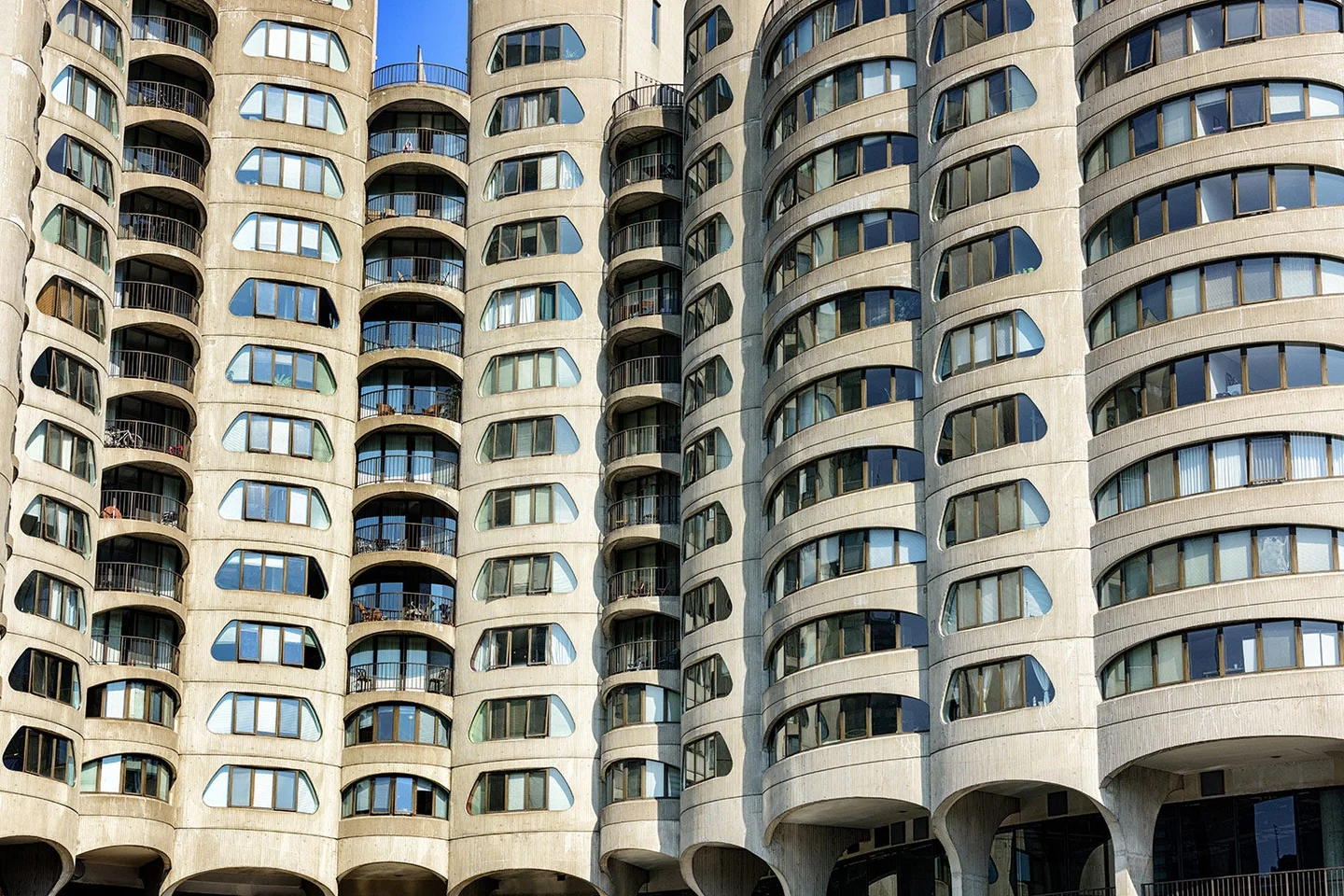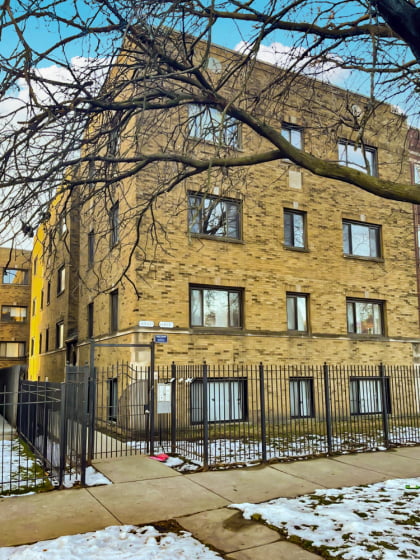08.04.21
How Condo Buildings End

Aggressive developers looking for a way in—or desperate homeowners looking for a way out.
Bertrand Goldberg’s famous River City complex in Chicago looks like nothing so much as an old bus operator’s coin dispenser, glass windows stacked inside its joined concrete cylinders. The South Loop megaproject was the architect’s try at a utopian urban neighborhood, complete with offices, shopping, restaurants, a park, and the “River Road,” a winding inner atrium lit from skylights. It’s a landmark of Brutalist design, a monument to ’80s thinking about cities, and a fixture of the Chicago Architecture Boat Tour.
The building also tells a story Goldberg could not have anticipated: the rise and fall of the Chicago condo. When completed in 1987, River City’s 448 units were rentals designed to appeal to middle-income yuppies who found city living attractive but homeownership out of reach.
In 2001, one cycle of gentrification later and at the start of a massive run-up in the Chicago housing market, the concrete icon was converted to condos. But prices never recovered after the 2008 crash, and owners soon found themselves unable to recoup their investment and facing major maintenance bills. Investors trying to cash in on Chicago’s hot rental market swooped in.
Making condos is easy. Unmaking condos is hard. When River City became a “deconversion” target in 2016, Chicago required 75 percent of owners to vote for a sale. (It’s now 85 percent.) Once that happened, everyone else was compelled to sell at the agreed-upon rate. Chicago-based developer Marc Realty made three offers over two years for River City. After owners agreed to sell for $100 million, Marc canceled the sale and dropped the offer by $10 million. While owners pondered the lower bid, Marc pitched additional deals to the holdouts—a process some owners on both sides of the vote later categorized in a lawsuit as bribery. Even after Marc’s hard bargaining, the sale was Chicago’s priciest deconversion recorded and its largest by unit count. River City is a rental building again, and its raw concrete atrium has been painted white, a concession to the tastes of today’s yuppie renters.
Stories like this make Chicago the perfect place to understand how condos usually meet their end—not in a pile of rubble, but in a buyout that leaves some owners feeling lucky and others feeling betrayed. Lauren Kerchill, the owner of a Gold Coast unit overlooking Lake Michigan, was a holdout when investors came to buy out her building. After fighting to toss her condo board, she told Crain’s Chicago Business she was called “petty,” “greedy,” and “uneducated.” She just didn’t think she could find another home like hers nearby. In the end, she didn’t have a choice. Her neighbors voted to sell her building, at 1400 Lake Shore Drive, for $107 million in 2019—another record, this time the most expensive deconversion in the country.
In an attempt to stand up for condo owners on the losing side of deconversion votes, the Chicago City Council decided in 2018 to increase the share of owners required to approve a sale, up to 85 percent from 75. “Most people, when they purchase a condominium, they are buying a home more than they’re buying an investment. So, a condo deconversion has a direct impact on people’s ability to plan their lives,” Alderman Michele Smith told the Chicago Tribune.* Deconversions were upending the retirement plans of Chicagoans who thought they would not have to move again, she said, and developers didn’t always just put things to a vote in order to take over a building.
Sometimes, developers bought up units on the sly, knowing that control over assessments and expenditures could come as soon as a majority. “Once you have a simple majority, it’s pretty much game over,” says Alex Argianas, a deconversion consultant in Chicago. When a bulk owner takes control, banks can balk at providing financing to new buyers. What if the bulk owner goes broke? That in turn makes it cheaper for investors to purchase the remaining units. The fewer retail owners to appease, the lower the deconversion bid (and the lower the payout for each unit). For investors, the approach is risky and slow, but potentially lucrative in a pricy rental market. That is what happened at 21 East Chestnut, also in Chicago’s Gold Coast neighborhood, where the developer Strategic Properties bought nearly 40 percent of the building before initiating a deconversion.
Professional landlords can pay above-market rates for apartments in deconversion sales, since the whole building is worth more than the sum of its units. They can finance and streamline the maintenance that bedevils amateur boards. They can join firms like Blackstone in profiting from a housing shortage at a time when low interest rates have pushed investors to find new ways to make money.
Longtime homeowners tend to think that’s not fair. Lawsuits abound, and some Chicago condo boards are starting to play defense by amending their bylaws to head off takeovers. But there’s another side to the story, in which deconversion is the only way out for condo owners stuck in deteriorating properties. In June, the collapse of Champlain Towers South in Surfside, Florida, drew attention to the challenges that confront condo boards as they assess structural damage and raise money for repairs. Maintenance bills for the Great American Condo Boom of the ’70s and ’80s are starting to come due in areas like South Florida.
This is also a reason Chicago is the nation’s capital of deconversion, a place where great swaths of owner-occupied apartments are being replaced with rentals.
While states like Florida, California, and Hawaii saw tons of new condo construction in the decades after the concept was established in the 1960s, Chicago saw a different kind of boom: older buildings becoming condos. Fearing rent control, facing declining profits, or saddled with obsolete prewar commercial space, landlords in Chicago raced to sell off their units in the 1970s. Yuppies and middle-class workers gobbled up these starter apartments, which provided an easy and cheap entry point to homeownership.
Fifty years later, those buildings are among the oldest condominiums in the country. Owners who have not kept on top of maintenance, and even some who have, sometimes find themselves facing massive repair bills.
Andy Friedman represents condo boards that are trying to find an exit strategy. One recent project featured 115 units among 113 owners. “Their resale values were stuck in the mud, and it was glaringly obvious that it was worth more as apartments,” he said. “Units that could never sell over $200,000 got $250,000. Absolutely they get more for their unit—otherwise, why do the deconversion in the first place?”
When boards fail to drum up support for a deconversion, Friedman said, values can fall quickly once a bulk owner enters the picture or maintenance problems become apparent. In one dilapidated building in the Oak Park suburb of Chicago, owners rallied for a sale with 78 percent of the vote. Had Oak Park been subject to Chicago’s new rule requiring 85 percent, Friedman said, the owners would have “raced each other down the toilet,” panic-selling their high-maintenance units to professional landlords one by one.*
Often, deconversions are battles fought less between owners and investors than among the owners themselves. David Lampert managed operations at Kennelly Square, a 22-story building in Lincoln Park built in 1970. Like River City, Kennelly Square had gone from rentals for nurses and flight attendants to condos for young traders and retirees. Starting in 2003, Lampert shepherded the condo association through some significant construction projects, including rebuilding the pool deck. But a multimillion-dollar bill for replacing the windows broke this spirit of collaboration.
Families and older, longtime residents who planned to live out their days overlooking the park were ready to spring for new windows. Younger owners and investors renting out their units balked, and prompted the search for a buyer. Kennelly Square was sold to Strategic Properties for $78 million in 2018. Some owners felt the deconversion offer they received was the best one they’d ever get. Others said they were forced to sell their renovated, well-kept apartments in an expensive neighborhood at a discount.
At the end of the day, Lampert said, it wasn’t even that anyone was being shortsighted or irrational. Long-term buyers rightly placed a high value on staying in a place they loved and recognized their deconversion payout wouldn’t get them much nearby. Newer buyers rightly realized they’d be paying a huge assessment for a 40-year improvement that would never make its way into their resale price when they flipped in four years. The sale was approved by a couple of votes, and nearly a quarter of the owners were forced to sell against their wishes.
“The Kennelly Square deconversion should live on in the annals of condominium history as an example of what can happen when board members do not perform needed maintenance on a timely basis,” the broker Bruce Theobald, who owned a condo in the building and voted to sell, emailed to Crain’s Chicago Business.
Today, it’s K Square, and there’s a shuffleboard table in the common room.
